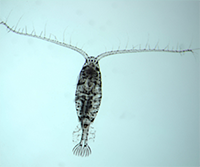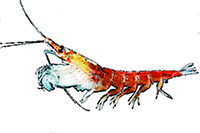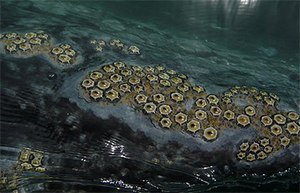Glossary
Activism
The policy or action of using vigorous campaigning to bring about political or social change. Activism can take many forms.
Aleutian Islands
A chain of 14 large volcanic islands and 55 smaller ones, off the southwest coast of Alaska, belonging to both the United States and Russia.
Anthropogenic
Originating in human activity (chiefly of environmental pollution and pollutants).
Biocenosis
An association of different organisms forming a closely integrated community.
Biotope
The region of a habitat associated with a particular ecological community.
Copepod
 A small or microscopic aquatic crustacean of the large class Copepoda.
A small or microscopic aquatic crustacean of the large class Copepoda.
Dorsal fin
A dorsal fin is a fin located on the backs of various unrelated marine and freshwater vertebrates, including most fish, as well as cetaceans (whales, dolphins, and porpoises).
Ecosystem
A contraction of "ecological system."
A natural interactive system established between biocoenosis (a group of living creatures) and their biotope (the environment in which they live). This term was coined in 1930 by British botanist Roy Clapham to denote the physical and biological components of an environment considered in relation to each other as a unit, later refined by British ecologist Arthur Tansley.
Krill
 Euphausiids or Krill are small shrimp-like marine crustaceans found in all world's oceans although some species are found inside the continental shelf (at depths of less than 200 m). There are over 80 species of Euphausiids. The average krill is about one to two centimetres in length, a few species grow to 6–15 cm and can live up to 10 years.
Euphausiids or Krill are small shrimp-like marine crustaceans found in all world's oceans although some species are found inside the continental shelf (at depths of less than 200 m). There are over 80 species of Euphausiids. The average krill is about one to two centimetres in length, a few species grow to 6–15 cm and can live up to 10 years.
Pelagic
Of or relating to the open sea.
Trophic level - simplified
In ecology, the trophic level is the position that an organism occupies in a food chain - what it eats and what eats it.
- Plants - produce their own food by photosynthesis, harvesting energy from the sun.
- Herbivores - eat the plants.
- Carnivores - eat the organisms that eat the plants.
- Note that there are sub-levels among carnivores. As examples, the fish that eats other fish is eaten by dolphins or whales. This can become a complex web - consider the fish that eats other fish, that fish is eaten by seals, and the seals are eaten by dolphins, such as orca.
Each layer of this system absorbs toxins from its diet, the original of toxic contamination causes a greater effect on organisms at higher levels. As an example, let's assume the plants are contaminated with 1 degree of toxicity. The fish that eats many plants, as its sole diet, could present 3 degrees of toxicity. The fish that eats these fish, consuming many as its diet, could present 10 levels of toxicity. The seal that consumes many fish, would be possibly 20 levels of toxicity. This leads to the orca that eats the seals, at 40 levels of toxicity.
This explanation is very much over-simplified with arbitrary 'degrees of toxicity' and given in this way only to illustrate the concept.
Whale barnacle
 Belonging to the class Crustacea and believed to be one of the oldest surviving life forms on the planet, whale barnacles attach themselves to the bodies of sea turtles, baleen whales, and dolphins during the barnacles' free-swimming larval stage. These barnacles are not parasites; they are filter-feeders. They do not feed on the host whale, but on the plankton in the waters traveled by their host.
Belonging to the class Crustacea and believed to be one of the oldest surviving life forms on the planet, whale barnacles attach themselves to the bodies of sea turtles, baleen whales, and dolphins during the barnacles' free-swimming larval stage. These barnacles are not parasites; they are filter-feeders. They do not feed on the host whale, but on the plankton in the waters traveled by their host.
Whales can carry tremendously large numbers of barnacles attached to their skin. One humpback whale can host a thousand pounds of barnacles without any problems. Too many barnacles can cause drag, minor skin irritations, and infections. On the up side, gray whales have been known to roll over when under attack from other whales, presenting their enemies with their hard, spiny barnacle 'armor.'
